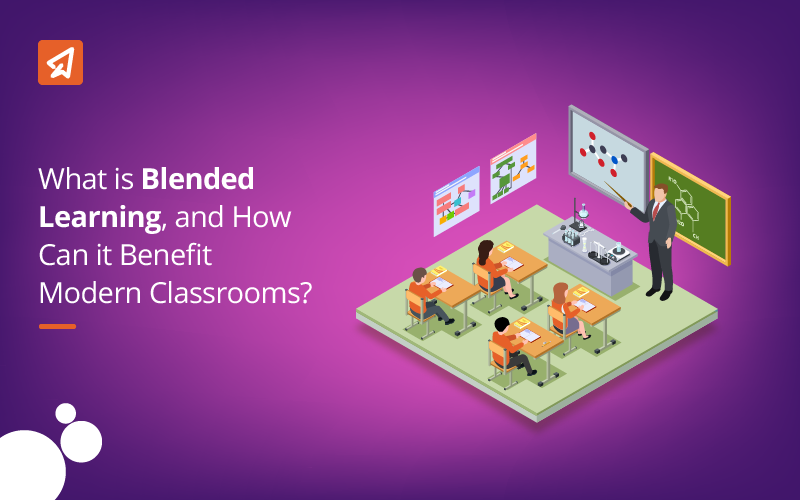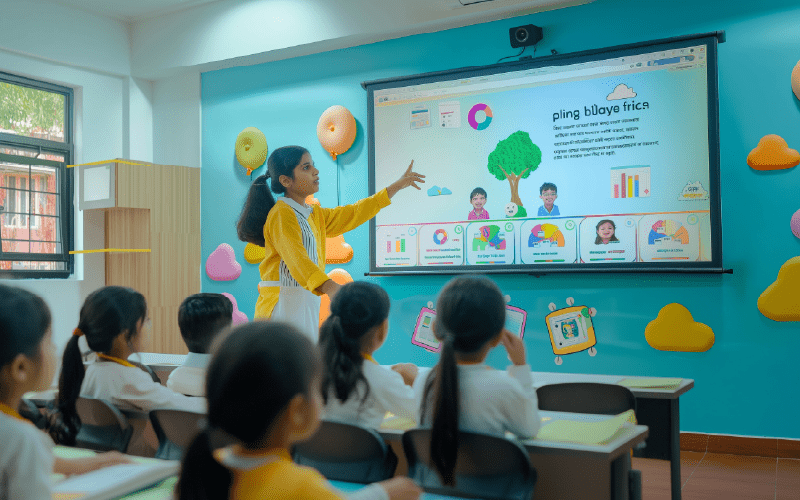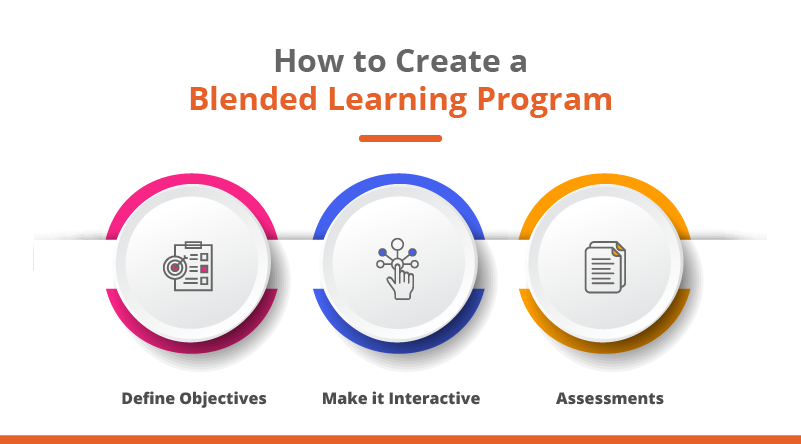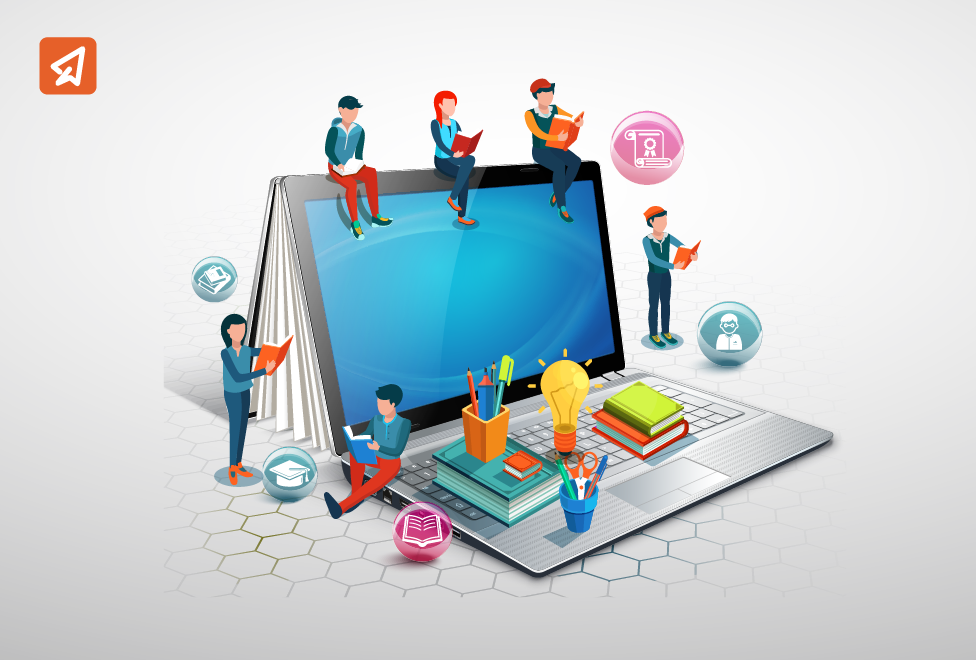What is Blended Learning, and How Can it Benefit Modern Classrooms?

In the ever-evolving landscape of education, the concept of blended learning has emerged as a transformative force, offering a powerful way to adapt to the changing needs of students and educators alike. As we delve into the world of blended learning, it’s crucial to recognise its growing importance, especially in the context of Indian K-12 education. Recent data from the National Sample Survey Office (NSSO) in India revealed that there are approximately 370 million students enrolled in K-12 schools across the country. With such a vast student population, the need for innovative and flexible teaching approaches becomes apparent.
Let’s explore how blended learning is reshaping the Indian K-12 education landscape, harnessing the potential of digital tools and traditional pedagogy to create a more effective and engaging learning experience for both teachers and students. Join us on this journey as we unravel the strategies, benefits, and challenges of implementing blended learning in the Indian education system.
What is Blended Learning?

Blended learning is a sophisticated learning approach that seamlessly integrates traditional instructor-led classroom training with online learning activities.
Unlike fully virtual eLearning, blended learning doesn’t replace face-to-face interaction with teachers; instead, it cleverly incorporates technology to enrich the learning experience and deepen understanding of specific subjects. For instance, teachers might share a video link for students to watch at home, encouraging them to share their reviews via email and then facilitating in-depth discussions during class.
Let’s take a look at some examples to illustrate how it works:
Example 1: Group Projects
- Face-to-face approach: Students collaborate in a classroom setting to contribute to a project.
- Blended learning approach: Utilising messengers, online communities, and task managers, students plan and coordinate their work. Additionally, file-sharing services like Google Docs become crucial for collaborative efforts and feedback sharing.
Example 2: Foreign Language Conversations
- Face-to-face approach: Learners engage in pairs or small groups during a lesson to practice foreign language conversation on a specific topic.
- Blended learning model: Beyond in-class discussions, learners leverage online services such as text and voice chat platforms like Discord to supplement their language practice.
Blended learning is like getting the best of both worlds – it combines traditional in-person learning with online learning to create a well-rounded and exciting way to learn.
Advantages of Blended Learning:

Dive into the future of education with Extramarks Smartclass Plus! Our blend of interactive technology and personalised learning is the perfect match for your school’s journey into blended learning.
Ready to elevate the classroom experience?
Types of Blended Learning Models:
-
- Face-to-FaceThis model is a lot like a regular classroom setup. You attend a live online class, like on Zoom or Google Meet, where a teacher gives you lessons. After each class, you have homework or assignments to do before the next one.
- RotationThe rotation model is one of the most common types of blended learning. Here, students rotate between different stations throughout the day, with each station focusing on a different type of learning activity. One station may focus on online learning, while another may focus on small group instruction or individual work.
- FlexThe flex model of blended learning is characterised by a high degree of flexibility and personalisation. In this model, students work primarily online, with the teacher providing support and guidance as needed.
- GamificationOne highly effective strategy for inspiring learners is incorporating an element of play into the educational process. When you introduce game-like features such as points or levels, it injects a sense of friendly competition, driving learners to engage with the material at their own pace and on their own terms.
- À La Carte ModelThe à la carte model of blended learning allows students to take individual courses online while still attending traditional face-to-face classes for other subjects. This model is often used by schools that do not offer a wide range of courses or by students who need to take courses that are not offered at their school.
- Online LabThe online lab blended learning model is all digital, mostly without direct teacher interaction. It happens before, during, or after training, and students can use mobile phones, laptops, or tablets to access the learning material. This way of learning keeps students engaged and helps them remember what they’ve learned.
70% of students claim skill building through Extramarks
- Flipped Classroom ModelThe flipped classroom model involves students watching online lectures or completing online assignments at home and then attending traditional classes for discussion and group work. We already have an in-depth guide for the fixed classroom model, and you can read it by clicking here.
- Self-BlendSelf-blended learning involves additional resources—such as webinars, white papers, industry blogs, or video tutorials—that empower individuals driven to expand their knowledge on a specific subject. A sophisticated Learning Management System (LMS) can seamlessly integrate various content outlets into a single system, fostering curiosity and facilitating continuous personal growth.
 Online DriverThe online driver learning model provides learners with a high degree of autonomy. Participants navigate through the learning modules at their own speed, driven by their individual motivation and determination. Although learners have the option to communicate with trainers when necessary, such communication is not obligatory for successfully completing the training.
Online DriverThe online driver learning model provides learners with a high degree of autonomy. Participants navigate through the learning modules at their own speed, driven by their individual motivation and determination. Although learners have the option to communicate with trainers when necessary, such communication is not obligatory for successfully completing the training.

Seamlessly integrate online and offline learning with 60+ printable smart classroom activities. Download now!
How to Create a Blended Learning Program

Creating an effective blended learning program involves several key steps:
Hassle-Free Assessments with Extramarks: A scientifically designed platform for facilitating and automating assessment activities.
Strategies for Effective Blended Learning
- Goal Setting for Student SuccessHelping students set goals is important for their success. When students and teachers work together to create goals, it makes students feel empowered and helps them develop skills they’ll use throughout their lives. Having regular meetings to check on progress and reach goals is a great way to make sure students are doing well. Focus on one or two goals at a time, and make sure they are specific, measurable, achievable, relevant, and time-bound. This way of setting goals aligns with the key principles of blended learning.
- Diverse Instructional MaterialsWhen it comes to blended learning, it’s good to use a mix of different materials and methods. Instead of just using textbooks, include things like internet resources, online discussions, personalised teaching materials, and test prep resources. A well-rounded day in a blended classroom could include activities from the internet, reading from textbooks, discussions led by the teacher, group activities, and homework from textbooks or eBooks. Mixing things up like this keeps learning interesting.
- Integration of TechnologyUsing technology in Career and Technical Education (CTE) courses can make lessons and lab work better. Whether you’re directly teaching with technology or using it to support learning, make sure it has a purpose. For example, using videos, online discussions, and interactive games fits well with how people learn today. Use technology in a way that helps students understand and remember things better.
- Exploring New Teaching TechniquesBlended learning lets you try out different ways of teaching. It’s effective to adjust lessons based on individual student needs. For instance, you can offer different versions of a lesson depending on what students prefer. Another useful technique is flipping the classroom, where students do typical homework at home, leaving class time for discussions, projects, and hands-on activities.
- Diversified AssessmentsWhen it comes to blended learning, it’s important to use different ways to check how well students are learning. Mix traditional tests with digital quizzes, essays, presentations, and assignments that students or their peers can assess. This variety not only fits with blended instruction but also gives students different ways to show what they know, taking into account their strengths.
- Implementing a Curriculum SystemA digital curriculum system makes blended learning in CTE classrooms smoother. It combines traditional teaching with technology seamlessly. Using a curriculum system involves starting with an interesting activity, introducing concepts through presentations and online lessons, doing digital review exercises, and ending with creative projects or assessments.
- Visualize-Represent-Share StrategyThis strategy has students create visual representations related to lesson concepts. It supports visual learners and helps all students understand lessons better.
- Discussion Points/PromptsEncouraging accountable talk, this strategy ensures all students participate in group discussions. Students earn points for sharing responses to discussion questions, fostering engagement and a deeper understanding of unit objectives.
- Frontloading VocabularyIntroducing key vocabulary before or during a unit helps students understand and use words effectively. This step-by-step process makes the content easier to understand and builds students’ academic language skills.
- Collaborative LearningWorking together helps activate what students already know, build on what they’ve learned before, and apply their thinking after a lesson. Collaborative learning is effective in planning projects and doing lab activities.
- Introduce Choice Boards and MenusChoice boards and menus let students choose tasks or paths that work for them. This strategy supports personalised learning, student agency, rigour, and relevance in blended learning.
Experience the future of education with Extramarks Smart Class Plus – where traditional learning meets technology. Don’t miss out on transforming your school; connect with us today and take the first step towards educational excellence.
Closing Thoughts
Extramarks’ Smart Class Plus brings technology into classrooms to make learning more exciting by converting them into dynamic smart classrooms. It has videos, interactive lessons, and tests that help students understand lessons better. This way of learning suits different students’ styles and makes education more inclusive. The use of smart devices and interactive whiteboards turns regular classrooms into lively places where students can work together and think critically.
In the world of blended learning, Extramarks’ Smart Class Plus is a great example. It mixes traditional and modern teaching methods, giving students a complete learning experience. It is a platform essential for the future of education, helping students not just with their school subjects but also preparing them for the digital world.
Reach out to us now and revolutionise your school with our cutting-edge Smart Class Plus solution.
Last Updated on April 4, 2025
Reviewed by

Priya Kapoor | AVP - Academics
Priya Kapoor is an accomplished education professional with over 18 years of experience across diverse fields, including eLearning, digital and print publishing, instructional design, and content strategy. As the AVP – Academics at Extramarks, she leads academic teams in creating tailored educational solutions, ensuring alignment with varied curricula across national and international platforms...read more.







































